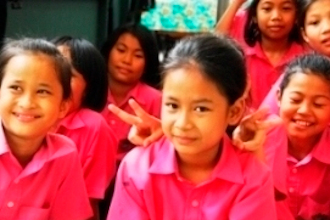Assessment Based National Dialogue
SPF Good Practices Guide
The social protection floor (SPF) is a basic set of social security guarantees that should be extended to all. Following the adoption of the Social Protection Floors Recommendation, 2012 (No. 202), by the International Labour Conference (ILC) at its 101st Session in June 2012, "creating and extending social protection floors" became an Area of Critical Importance (ACI) for the International Labour Organization (ILO).
In the East and South-East Asia and the Pacific, the establishment of social protection floors has increasingly been recognized by ILO member States as an efficient approach to combating poverty, inequality, and exclusion and as a key element of national development strategies. The level of engagement on social protection among ILO member States has increased significantly as evidenced by the number of Decent Work Country Programmes (DWCPs) and United Nations (UN)/government development frameworks that prioritize the development of social protection and the provision of basic social security guarantees. The ILO has taken a leading role in promoting social protection floors and supporting member States in designing and implementing their national social protection strategies.
The design and establishment of social protection floors is a new area of work for the Organization, requiring the development and testing of new methodologies and tools to aid in the assessment of social protection situations, provide compelling and evidence-based recommendations to governments, ensure the sustainability of financing, and support the development of innovative implementation strategies and mechanisms in accordance with national circumstances.
This guide is a unique resource package that aims to provide the necessary knowledge and expertise for conducting assessment based national dialogue (ABND) exercises, which are the first steps towards the implementation of nationally defined social protection floors. Designed by practitioners for practitioners, it is based on real country cases and experiences. Its standardized and systematic approach can serve several purposes, including self-learning, delivering trainings or conducting full-fledged ABND exercises at the national level. It will be enriched in future with new experiences. It is structured along the lines of the ABND approach and includes hands-on exercises to allow users to gain practical knowledge and understanding.

Acknowledgement by the authors
The authors gratefully acknowledge the support received from all those involved in conducting ABND exercises in Cambodia, Indonesia, Thailand, and Viet Nam over 2011–2013: ministries and institutions in charge of social protection policies, planning agencies, social security institutions, research institutes, national statistical offices, workers’ and employers’ representatives, civil society organizations, and representatives and colleagues from UN agencies involved in the SPF Initiative. Special gratitude goes to the authors of the ABND reports (in alphabetical order): Florence Bonnet, Michael Cichon, Carlos Galian, Jean-Claude Hennicot, Gintare Mazeikaite, Orawan Prasitsiriphol, Dr Thaworn Sakunphanit, Sinta Satriana, Wolfgang Scholz, and many others who contributed to the compilation and production of the reports.
The authors also value the support of the Faculty of Economics, Chulalongkorn University, Bangkok for organizing the training course on "Social Protection: Assessment, Costing and Beyond" in October 2012, where a preliminary version of this guide was tested. Feedback from participants of the course helped enrich the guide. Special thanks goes to all the experts and consultants who have contributed to the course or the dissemination of the ABND methodology in Asia and the Pacific (in alphabetical order): Rachael Chadwick, Charles Crevier, Sophy Fisher, Jean-Claude Hennicot, Michael Glowacki, Marion Maurice, Tauvik Muhamad, Malika Ok, Celine Peyron-Bista, Piyamal Pichaiwongse, Orawan Prasitsiriphol, Dr Thaworn Sakunphanit, Sinta Satriana, and Jessica Vechbanyongratana.
Finally, the authors are grateful to Florence Bonnet, Jean-Claude Hennicot, Celine Peyron-Bista, Dr Thaworn Sakunphanit, Jessica Vechbanyongratana, and Hiroshi Yamabana for peer-reviewing the guide.
The authors are solely responsible for the contents and especially, any opinions expressed in the guide.
- Valerie Schmitt and Loveleen De
About the training course on "Assessment, Costing and Beyond"
What is the assessment based national dialogue?
A window of opportunity for social protection
Getting started
What is SPF?
A social protection floor (SPF) is a nationally defined set of basic social security guarantees, that aims to prevent or alleviate poverty, vulnerability, and social exclusion. By calling for both demand-side (transfers) and supply-side (services) measures, the SPF adopts a holistic approach to social protection. Countries are encouraged to prioritize the implementation of SPFs both as a fundamental element of their national social protection systems and as a starting point for the provision of higher levels of protection to as many people as possible, and as soon as possible, in accordance with growing economic and fiscal capacities.
SPFs should comprise, at least, the following nationally defined sets of goods and services or basic social security guarantees:
- Access to essential health care, including maternity care, at a nationally defined minimum level that meets the criteria of availability, accessibility, acceptability, and quality;
- Basic income security for children at a nationally defined minimum level, including access to nutrition, education, care, and any other necessary goods and services;
- Basic income security at a nationally defined minimum level for persons of active age who are unable to earn sufficient income, in particular in the case of sickness, unemployment, maternity, and disability; and
- Basic income security at a nationally defined minimum level for older persons.
The components of the SPF or guarantees are defined in accordance with national social protection systems and circumstances, to give flexibility in establishing an SPF. The four guarantees set minimum performance or outcome standards with respect to the access, scope, and level of income security and health care, rather than prescribing a specific architecture of social protection systems, programmes, and benefits. While not all countries can establish all the SPF guarantees immediately, the SPF provides a framework for progressively implementing a holistic social protection system with linkages between the different guarantees.
The usefulness of the SPF approach in combating poverty has been increasingly recognized at the international level, especially since the onset of the global financial crisis of 2007-08. In 2009, the High Level Committee on Programmes of the UN Chief Executives Board adopted the Social Protection Floor Initiative (SPF-I) as one of several joint initiatives to combat and accelerate recovery from the global economic crisis. The SPF has also been highlighted by the Group of 20 Finance Ministers and Central Bank Governors (G-20), and incorporated as a central pillar of the post-2015 UN development agenda for inclusive development.
Building on this foundation, the International Labour Conference adopted the Recommendation concerning national floors of social protection (Social Protection Floors Recommendation, 2012 (No. 202)) at its 101st Session in 2012. Recommendation No. 202 reaffirms the role of social security as a human right and as a social and economic necessity, and provides guidance to countries in building SPFs within progressively comprehensive social security systems.
While the Asia and the Pacific region has made considerable economic progress in the last two decades and has lifted millions out of poverty, not all have benefitted from these gains. Millions of people are still poor, deprived of basic rights, and vulnerable to increased risks from economic crises and climate change. The threat that human development gains made in the past decade may fail to stick and begin to reverse, has helped place social protection high on the policy agenda in the region. At their 67th Session in May 2011, Member States of the UN Economic and Social Commission for Asia and the Pacific (UN ESCAP) passed a resolution on strengthening social protection systems in Asia and the Pacific. At the 15th Asia and the Pacific Regional Meeting (APRM) held in December 2011 in Kyoto, tripartite stakeholders determined that building effective social protection floors, in line with national circumstances was one of the key national policy priorities for the Asia and the Pacific Decent Work Decade. The recent adoption of the Declaration on strengthening social protection by ASEAN Member States confirms the growing regional importance of social protection.
In order to identify understand what elements of national SPFs are in place and where holes in the system exist, the ILO collaborated with governments, social partners, civil society, academicians, and UN agencies of the ASEAN region in 2011-13 to conduct social protection assessment based national dialogue exercises in Cambodia, Indonesia, Thailand, and Viet Nam.
What is ABND?
The ABND exercise assesses whether the SPF is a reality for the whole population of a country and how it can be extended to all members of society. Policy gaps and implementation issues in the social protection system are identified. Recommendations for new or expanded social protection provisions are developed, that guarantee an SPF to all residents and children. The ABND also estimates the financial commitment required to implement the recommendations. During the second stage of the ABND, the Rapid Assessment Protocol (RAP) cost-estimation tool is used to estimate the cost and affordability of implementing the recommendations in each country.
This process takes over one year and entails bilateral consultations, tripartite workshops, and technical seminars. A shared vision of the social protection situation is progressively developed, including the identification of policy gaps and implementation issues. At these meetings, policy recommendations are also drawn up, to achieve a comprehensive SPF that also adheres to international labour standards. The participatory approach adopted throughout the ABND exercise raises awareness among line ministries, workers and employers representatives, civil society organizations, and UN agencies regarding the SPF concept, its relevance for every country, and the importance of a coordinated and holistic approach to effectively develop social protection.
The ABND is based on national social dialogue with stakeholders in the social protection system of a country. This allows the information to be captured and represented from various perspectives and enables progressive consensus building on key ideas. This also contributes to the holistic design of a national SPF that aligns with the visions of different stakeholders. Together with the RAP, the ABND acknowledges that policy recommendations must be affordable, while providing flexibility for schemes to be scaled up as more fiscal space becomes available.
The ABND approach adheres to the four SPF guarantees, as set out in ILO's Recommendation No. 202. The methodology for conducting ABND exercises was developed by the ILO in East, South-East Asia and the Pacific and practically tested in Cambodia, Indonesia, Thailand, and Viet Nam. It was then standardized through the development of the Social protection assessment based national dialogue: A good practices guide. A preliminary version of the guide has been tested at workshops at the national and regional levels, and used for starting or planning ABND exercises in Lao People's Democratic Republic, Mongolia, Myanmar, Philippines, the Solomon Islands, and Vanuatu. The ILO continues to promote the ABND approach through technical and policy guidance to stakeholders involved in similar activities, and hands-on training workshops.
Using the guide
The SPF good practices guide offers a standardized approach for conducting ABND exercises. The contents of the guide draw from the resources and experiences of the ILO and its constituents in East and South-East Asia and the Pacific. The Guide is a comprehensive resource package that can be used for self-learning, training and conducting ABND exercises. It is structured in such a way that it follows the steps of the ABND exercise.
The guide is available in two formats: textbook (publication) and a complementary e-box (website and CD). It is organized into 16 modules, case studies and a library. The textbook comprises modules that describe the ABND exercise, and the case study of a fictitious country called Coresia. The case study is designed to simulate the ABND exercise and give users practical experience of conducting the ABND. In addition to the modules and case study, the e-box also contains presentations, videos and self-learning tutorials, instructions for group activities, and a cost-estimation model for Coresia.
The contents of the guide were tested at a training workshop on "Social Protection: Assessment, Costing and Beyond" in Thailand in October 2012 and in consequent regional and national workshops. The subsequent modules contain videos, photos and group activities from the workshop, to illustrate the contents of the guide.
The intended audience of the guide includes all practitioners involved in conducting the social protection ABND exercise:
- decision-makers and staff from various ministries in charge of social protection policies, planning agencies, social security institutions, and national statistical offices;
- staff from research institutes, universities, and training institutes;
- workers and employers representatives and civil society organizations; and
- colleagues from UN agencies involved in the SPF Initiative.
A social protection floor for all
Why is ABND relevant to the ASEAN?
Voices of stakeholders
Modules
Introduction

Step 1: Building the assessment matrix

Step 2: Costing policy options using the RAP model

Case studies
To give participants practical knowledge of the ABND process, a case study exercise has been designed. The cases are based on a fictitious country called Coresia, which endeavours to develop a comprehensive social protection system and complete its social protection floor.
Modules 8, 10, 11 and 14 use the case study exercise to simulate and practically illustrate the ABND approach. Users can download the cases, along with questions and instructions to analyze them. Sample solutions are also provided, to guide users in solving the cases.
Cases

Module 8
Case study and assessment matrix
Module 10
Group activity - Converting recommendations into scenarios
Module 11
- Instruction sheet - Calculating the cost of benefits using RAP
- Instruction sheet - Presenting the RAP results to other groups
- Blank RAP model
- Completed RAP model
- Health - Sample solution
- Children - Sample solution
- Working age - Sample solution
- Elderly - Sample solution
- Maternity - Sample solution
- HIV - Sample solution
Group activity - Calculating the cost of benefits using RAP
Module 14
Launching event for the report
Group activity - Advocacy to the government

